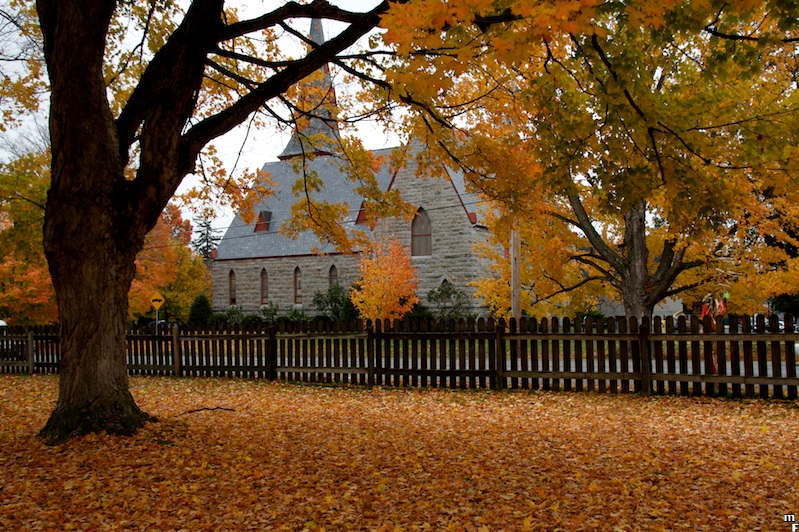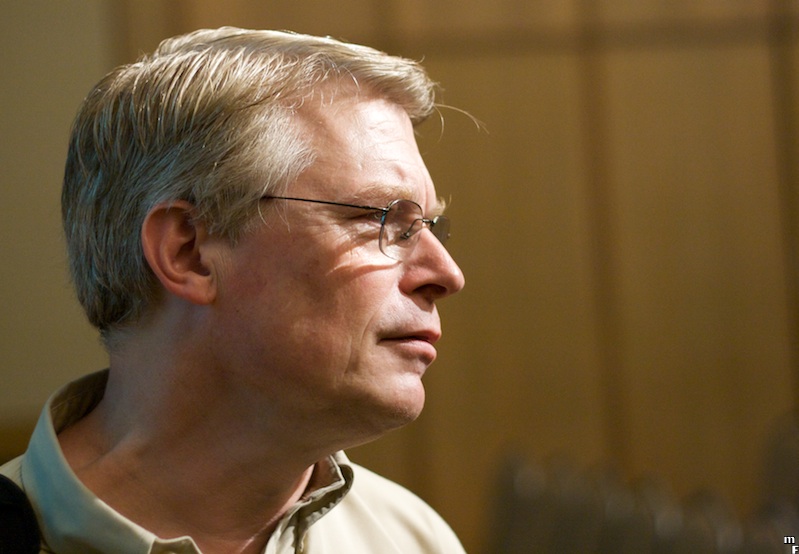Digital SLR
7 August 2009
Like many geeks I'm into photography. We geeks like photography because it provides the veneer of an artistic endeavor while allowing us to indulge in lots of technical details and spend money on expensive toys. A friend recently asked about my camera buying decisions, a question that prompted me to write them down.

I got my first digital SLR a year ago. Before that I had owned a film SLR for many years, but started using digital cameras around 2000. I found the convenience of digital to be compelling and stopped using the film camera. I toyed with getting a digital SLR in 2004, but instead decided on a high end fixed lens camera - the Minolta A1. I enjoyed using it, but it conked out late in 2007. I considered a similar kind of camera, something like a Canon S5, but decided to bite the SLR bullet.
My first decision, and a critical one, was which system to buy. This is the critical decision as it's difficult (ie expensive) to reverse. Once you pick your system, you'll then commit money to it by buying lenses and the cost of switching is more than a dabbler like me can go with. I felt that the best choice was to go with the big two - Canon or Nikon. The choice between them was pretty much arbitrary, I ended up choosing Canon because a friend we occasionally vacation with has a Canon. A trifling distinction, but really the choice between the two wasn't a big one.
I'm still reasonably happy with it. One misgiving is that the technological advantage seems to have tipped in Nikon's favor over the last year, at least according to the blogs I read, but it's a tight race and Canon could well come back. I've also been recently intrigued by the new Micro Four Thirds format. Early days (and not around last year) but the small size and weight are very important to me.
With Canon as the choice, the next step was the initial choice of body and lenses. My approach was to get pretty much the cheapest body I could (the Digital Rebel XTI) because I'd rather spend more money on lenses than on the body. The whole point of SLRs is to have good lenses, so I'd rather concentrate my limited dollars there. Cameras also get upgraded much more frequently, so I'm likely to upgrade the camera in a few years while lenses stay current for much longer.

So which lenses? I forgoed the kit lens and got the camera body-only. As my main lens I went with a mega-zoom, the Sigma 18-200. Serious photographers will, probably rightly, turn their noses up at this lens. But I'm a dabbler. Most of my photos will only be seen on my screensaver or on a web page. A few get printed for a wall of our house, but only on a regular letter size printer. So I doubt that I'd appreciate the difference of a higher quality lens. Furthermore I can shoot within its limits. Reviews suggest that if you stick to f9, the quality stays pretty good. Since I'm mostly using it outside during the day, that limitation is easy to live with. As a result I tend to set my camera to aperture priority with f9, and that covers most of my shots.1
1: Although I've been pretty happy with this lens, if I were buying now, I'd go for the Canon 18-135 since it's rather smaller and lighter, for a minor loss in reach.
The advantages of a single mega-zoom are considerable to me. Most of my photographs are taken while I'm doing something else, often with others around. I don't go out much to just shoot. In that situation even changing lenses can be a significant deterrent to getting a shot. Furthermore size and weight are a big deal when I'm travelling. While the lens isn't exactly svelte, it's much more compact that the alternative ways of getting that kind of zoom range. A final bonus is that it's image stabilized, which allows me to use it for static interiors.
The mega-zoom stays on my camera most of the time, but it wasn't the only lens I got with my camera. I also picked up the f1.8 50mm. This is an easy lens to get, very cheap, very light, very small but produces great quality. Since it's the equivalent of a 80mm on 35mm film, it's ideal for portrait photos - particularly with the f1.8 aperture. I use it a lot for shooting people in low light conditions.
I toyed with other lenses, but I wanted to get used to those two before I plonked money on any more.
After a few months with the camera I turned my eyes to a tripod. There are varying views on the net about tripods, some feel you should only use them if you really have to, some that you should use them whenever you can. I do like having one around, particularly for crepuscular shooting. I had a cheap and crummy silk tripod, but Duncan's blog persuaded me that I should get something better. I didn't go for his preferred Gitzos (beyond my budget) but I did get a light Induro tripod, together with a Really Right Stuff head and fast release clamp.
I went for the lightest setup I could get, as I wanted something that I'd actually be prepared to carry around and my camera/lens combos aren't particularly heavy. The fast release clamp was important as I'm someone who like to move around when shooting and such a clamp makes a big difference. In hindsight I wish I'd paid the extra for an L clamp, as I do find it frustrating to futz with the head when switching orientations.

It was only a month or so more before I went for another lens. A trip out to Colorado and Utah was the trigger to think about something wider than the 18-200 would go. I considered the Tokina 11-16 and the Canon 10-22, going for the latter due to it being lighter. It's a fun lens to use, allowing a few different things than what my regular lens provides. In particular what's interesting to work with is the huge depth of field you can get with an ultra wide: at 10mm you can easily get everything from a foot to infinity.
This is probably a reasonable moment to talk about filters. There's a good bit of discussion on the net about whether putting on a UV filter is worthwhile. I decided to get one for the 18-200 as it's on my camera so much, but not to get ones for my other lenses as I use them much less and am prepared to be more careful when those lenses are on the camera. For the mega-zoom I also picked up a polarizing filter, which I carry around with me all the time, but frequently forget to use.
The other issue that obsesses camera people is how to carry all this stuff. All things being equal, I like weight on my waist. So I went for a waist belt (from Tamrac, due to the double belt layout) and a Think Tank holster. I like the Think Tank's ability to extend when I have the hood on my lens. The only problem is that there are plenty of occasions when a waist belt isn't an option. The holster comes with a shoulder strap, which is fine, but I usually want the 10-22 as well. Cindy came to the rescue, sewing some straps onto the side of the holster so I can attach a lens pouch.
To keep track of my photos, and to do some post-processing, I got a copy of Apple's Aperture. (It seemed a toss up between Aperture and Lightroom.) I find it works well, better than sticking with iPhoto.
The latest lens I added to my collection is the Canon f2 100mm. I got this for shooting indoors, particularly at conferences for shooting someone on stage. In those situations I need more reach than the 50mm, but I still want a really fast aperture at a price and weight that's rather less than the serious zooms. So far I've only used the 100mm a couple of times, but have been very happy with it.
That burst of buying isn't something I expect to maintain. The quartet of lenses I have is pretty suited to my needs. There are some more I'm eyeing. The Canon 100-400mm zoom would be great for wildlife shots, but frankly we're rarely in the situation where I'd use it, so it's hard to justify its high cost. A different situation that regularly tickles my mind is cases where I'm primarily at a conference (so have the 50 and 100mm) but don't want to lug the 18-200 and want to have something wider. I could take the 10-22, but that leaves a gap and is less light than I'd like. Ironically this suggests the (now updated) kit zoom which is cheap and light. The primes less than 50mm are either too heavy, too expensive, or seem to have less quality than the kit zoom.
Since I've written this, I've added a CanonS90.
If you're curious, here are the results, (because there just aren't enough holiday snaps on the web.)
Notes
1: Although I've been pretty happy with this lens, if I were buying now, I'd go for the Canon 18-135 since it's rather smaller and lighter, for a minor loss in reach.

